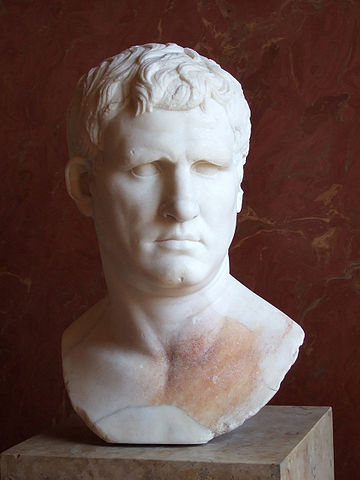Origins and Reconstrution

A bust of Marcus Vispanius Agrippa, a close ally and son-in-law of Augustus. He commissioned the original Pantheon.
The Pantheon that we see in Rome today is not the first to stand in this spot in the Campus Martius in ancient Rome. In fact, the current monument is the third Pantheon, constructed nearly 200 years after Marcus Vispanius Agrippa commissioned the original in 25-27 BC.1 Though studies are continuing to reveal more about the original Pantheon, much of its history, usage, and architecture are still left unknown.
In Greek, the name ‘pantheon’ would suggest that the monument was a temple dedicated to the worship of all gods, but it was never officially used or considered as such. According to Dio Cassius, an ancient historian, Marcus Agrippa had intended to dedicate the building to Emperor Augustus, his close ally and eventual father-in-law.2 Though Augustus rejected the honor, evidence shows that the Agrippan Pantheon possessed many features that strongly suggested Augustus’s apotheosis (divinization as emperor) and hinted at a clear linkage between Augustus and his adopted father, Julius Caesar. Though the Pantheon was not labeled in clear commemoration, Agrippa supposedly placed statues of Venus, Mars, Julius Caesar, Augustus, and himself within the rotunda. He insinuated the emperor’s divine linkage, and hence, affirmed his own importance as close ally.3
Around 80 CE, however, a devastating fire harmed Agrippa’s Pantheon and several other buildings in the Campus Martius.4 Emperor Domitian restored and rebuilt the Pantheon, but a lightning strike in 110 CE caused another fire that burnt the monument beyond salvage.5 This time, Emperor Trajan began a complete reconstruction of the building. Sources conflict about which emperor — Trajan or Hadrian — was more in charge of the design and completion of the Pantheon. Traditionally, the current Pantheon was associated with Hadrian, often called Hadrian’s Pantheon among academics. However, recent evidence including the time of construction and architectural features suggests that Trajan was more responsible for the new monument.6
__________________________________________________________________________
1 Tom Marder and Wilson Jones, The Pantheon: From Antiquity to the Present, (New York: Cambridge UP, 2015), 4.
2 Ibid., 49.
3 Ibid., 76.
4 Ibid., 51.
5 Ibid., 97.